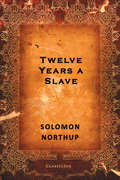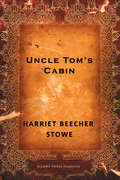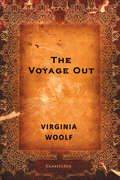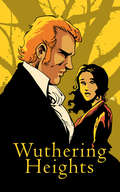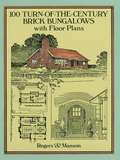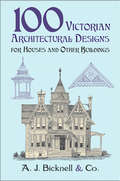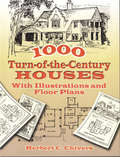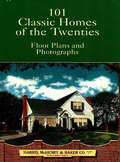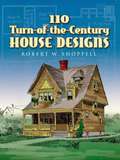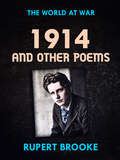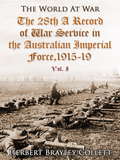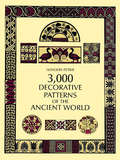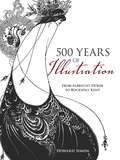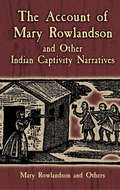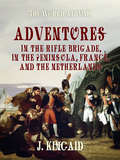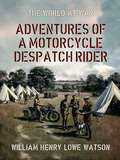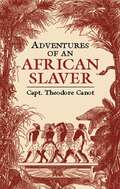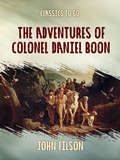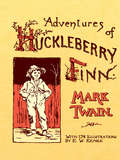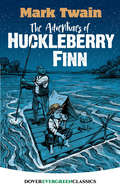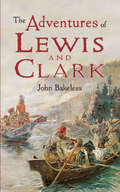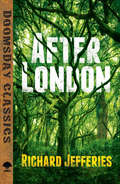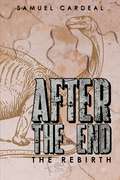- Table View
- List View
The Truth About the Titanic
by Archibald GracieOne of the last people to escape the sinking Titanic, Archibald Gracie gives a true and personal account not just of his experience escaping the doomed ship, but of the events that transpired in each lifeboat and the inquiry that followed one of the greatest maritime tragedies in history.Be it mystery, romance, drama, comedy, politics, or history, great literature stands the test of time. ClassicJoe proudly brings literary classics to today's digital readers, connecting those who love to read with authors whose work continues to get people talking. Look for other fiction and non-fiction classics from ClassicJoe.
Twelve Years a Slave (Amazing Values Ser.)
by Solomon Northup"This is no fiction, no exaggeration. If I have failed in anything, it has been in presenting to the reader too prominently the bright side of the picture."Solomon Northup-s best-selling memoir recounts his harrowing experience of being kidnapped and sold into slavery. First published in 1853, the book explores the horrors Northup endured as a result of his enslavement, and provides a shocking account of his struggles to reclaim his freedom. Twelve Years a Slave was made into an Academy-Award winning film starring Chiwetel Ejiofor, Lupita Nyong'o, Michael Kenneth Williams, Michael Fassbender, Paul Giamatti, and Benedict Cumberbatch.Be it mystery, romance, drama, comedy, politics, or history, great literature stands the test of time. ClassicJoe proudly brings literary classics to today's digital readers, connecting those who love to read with authors whose work continues to get people talking. Look for other fiction and non-fiction classics from ClassicJoe.
Uncle Tom's Cabin
by Harriet StoweThe lives and losses of slaves in the American south are portrayed in Harriet Beecher Stowe's unflinching indictment of slavery.When a benevolent landowner decides to sell two slaves—Uncle Tom and Eliza—in order to raise funds, the lives of the two slaves follow divergent paths. While Eliza escapes to eventual freedom, Uncle Tom is repeatedly sold until he ends up working on the prosperous Legree plantation, where his very life becomes forfeit to his violent master.Be it mystery, romance, drama, comedy, politics, or history, great literature stands the test of time. ClassicJoe proudly brings literary classics to today's digital readers, connecting those who love to read with authors whose work continues to get people talking. Look for other fiction and non-fiction classics from ClassicJoe.
The Voyage Out (Oxford World's Classics)
by Virginia WoolfA journey aboard a ship to South America releases a young woman from the strictures of life in Edwardian London. Through her encounters with her fellow passengers, Rachel Vinrace is exposed to new ways of thinking, and is encouraged to explore what her life could be if she set aside her rigorous and cloistered upbringing.Virginia Woolf's first novel, The Voyage Out employs a conventional approach to storytelling, and although Woolf later abandoned this traditional literary style in favour of a modernist approach, The Voyage Out nonetheless demonstrates her extraordinary skill as a writer from the outset of her career.Be it mystery, romance, drama, comedy, politics, or history, great literature stands the test of time. ClassicJoe proudly brings literary classics to today's digital readers, connecting those who love to read with authors whose work continues to get people talking. Look for other fiction and non-fiction classics from ClassicJoe.
Wuthering Heights
by Emily BrontëThe first and only novel written by Emily Bronte during her short career, Wuthering Heights is a tale of a passionate but jealous love affair between the mysterious Heathcliff and free-spirited Catherine Earnshaw. Far from a traditional romance, the novel does not shy away from portraying the destructiveness and resentment that can arise from love. Because of its stark portrayal of Heathcliff and Catherine's relationship and the cruelty and suffering that stems from it, Wuthering Heights was highly controversial when published originally in 1847. Now it is considered, alongside Charlotte's Jane Eyre, as the most enduring of all the Bronte Sisters works.
100 Turn-of-the-Century Brick Bungalows with Floor Plans
by Rogers MansonWhen Brickbuilder, an early 20th-century trade publication, sponsored a major nationwide competition for bungalow designs, over 600 drawings were submitted by architects and draftsmen from around the country. This book, reprinted from a rare catalog published in 1912, contains the 100 winning entries from that event. The competition had two important criteria: the principal construction material was to be brick, and the complete cost -- exclusive of the land -- would be about $3,000.The winning designs came from all over the United States and reflected a diverse range of tastes and styles -- from a single-floor, tile-roof hacienda to an elaborate thatched-roof English cottage, complete with decorative brickwork and a semicircular exterior wall. Each of the 100 superbly rendered plates shows the house in perspective and provides floor plans, some landscape planning, and an itemized list of construction costs.An essential reference book for restorers of period homes, historians, students, and enthusiasts of American domestic architecture, this fascinating book also offers browsers an entertaining glimpse of houses that still appear in countless areas across the country.
100 Victorian Architectural Designs for Houses and Other Buildings (Dover Architecture)
by A. J. Bicknell Co.Originally published in 1878, this now-rare collection of designs supplies views of a remarkable variety of modestly priced structures: houses, villas, cottages, many others. Handsome drawings of perspective views and elevations, some of which include floor plans, plus suggestions for interior design. 98 black-and-white illustrations.
1000 Turn-of-the-Century Houses: With Illustrations and Floor Plans
by Herbert C. ChiversA remarkable presentation of the "finished ideas of a practicing architect of high rank in his profession," this early-twentieth-century showcase of homes features a wide range of designs from a Midwest master. Reproduced from a rare edition, the work features a splendid array of dwellings, from cottages and bungalows to sprawling mansions. Each house is meticulously illustrated and accompanied by complete floor plans."A poorly planned house is usually more expensive than a modern practical plan," according to the author, architect Herbert C. Chivers. Combining "modern methods" with attractive but modestly priced plans, Chivers promoted his business with sketches of stylish homes, accompanied by brief captions stating dimensions, prices, and occasional suggestions for modifications. This reprint of his complete guide to domestic architecture of the early 1900s constitutes a valuable resource for home hobbyists, architecture students and professionals, as well as antique collectors.
101 Classic Homes of the Twenties: Floor Plans and Photographs (Dover Architecture)
by McHenry Harris Baker Co.Originally published in 1925 by the Harris, McHenry & Baker Company of Elmira, New York, this authentic plan book advertises 101 "modern homes," selected from several thousand submitted designs. Chosen for aesthetic appeal as well as utility of arrangement and economy of construction, the houses encompass a truly impressive array of sizes and styles. Now this meticulous reproduction of the company's plan book offers modern readers a look back at these charming residential homes of the 1920s.Detailed floor plans with measurements and an actual photograph of the completed dwelling accompany each model. Designs include "The Stratford," a Tudor-style brick-and-stucco home with a library and servants' quarters; "The Northcliff," a three-bedroom Dutch colonial with a sun parlor; "The Belvedere" and "The Strathmore," attractive two-family homes; and many others.Invaluable for restoring residences remodeled in the past, this handy volume will be of particular interest to owners of houses built in the 1920s as well as to restorers and preservationists in search of authentic plans.
110 Turn-of-the-Century House Designs
by R. W. ShoppellWith its wealth of representative styles and its emphasis on craftsmanship and exterior design, the late-Victorian era ranks among the halcyon days in American house building. This survey of the era's traditional designs--reproduced from a rare edition--offers a complete and authentic guide to faithful restorations or re-creations.A New York City-based firm prepared and published this catalog in 1897, selecting the very best models from more than 12,000 houses built from their plans. Designed with style, utility, and low cost of construction uppermost in mind, it features hundreds of illustrations, including perspective drawings and floor plans. Details of interior and exterior materials and potential modifications include remarks on the particular amenities of each house, plus estimates of building costs. Antique collectors, home hobbyists, and fans of traditional design will find this volume a valuable reference and an endless source of inspiration.
124 Distinctive House Designs and Floor Plans, 1929
by National Building PublicationsAn annual publication intended as a reference work for contractors, suppliers, architects, and homeowners, the 1929 Home Builders Catalog offered a beautifully illustrated look at a variety of homes. Painstakingly reproduced from a rare edition, this volume offers old-house restorers, preservationists, and lovers of 1920s architecture an authentic view of American homes of the era.
1914 and Other Poems (The World At War)
by Rupert BrookeRupert Brooke had planned to put together a second collection of poetry for the spring of 1915. However he died of blood-poisoning while serving in World War I and this collection was published posthumously in 1915. It includes the celebrated poem "The Old Vicarage, Granchester". (Amazon)
The 28th: A Record Of War Service In The Australian Imperial Force, 1915-19, Vol. I, Egypt, Gallipoli, Lemnos Island, Sinai Peninsula (The World At War #1)
by Herbert Brayley CollettA comprehensive description of Australia's mounted horse troops involvement in the First World War. From the formation of the 28th brigade light horse, through to their battles overseas.
3,000 Decorative Patterns of the Ancient World (Dover Pictorial Archive)
by Flinders PetrieMythical animals, florals, rosettes, religious and secular symbols, more.
500 Years of Illustration: From Albrecht Dürer to Rockwell Kent (Dover Fine Art, History of Art)
by Howard SimonAn unrivaled treasury of the methods, techniques, and examples of the great illustrators, this volume covers five centuries of decorations for the printed page. Ranging from the dawn of printing to the twentieth century, it offers working artists and students an unsurpassed reference and source of inspiration. It also forms a delightful browsing book for lovers of art and illustrated books.Starting with 16th-century woodcuts by Albrecht Dürer and Hans Holbein, the chronological presentation features works by Goya, Hogarth, Blake, Morris, Doré, Toulouse-Lautrec, Beardsley, and other masters. A brief text introduces each section, and the volume concludes with an international roster of modern artists, categorized by country. All that is best and outstanding in the field of illustration appears here, in this giant book of sketches, engravings, woodcuts, and lithography.
The Account of Mary Rowlandson and Other Indian Captivity Narratives (Dover Books On Americana Ser.)
by Mary Rowlandson Horace KephartThe wife of a minister in a small frontier town west of Boston, Mary Rowlandson was forced to leave her house in the late winter of 1676 after marauding Indians set the building on fire. "I had often before this said," she later wrote, "that if the Indians should come, I should chuse rather to be killed by them than taken alive but when it came to the tryal my mind changed; their glittering weapons so daunted my spirit, that I chose rather to go along . . . than to end my days."Thus began Mary Rowlandson's account of her arduous journey as a servant to her captors, the Narragansett Indians. The most celebrated such document in American history, her record of the three months she spent in captivity tells of hardship and suffering, but also includes invaluable observations on Native American life and customs. The text is notable, as well, for conveying an understanding of her captors as individuals who not only suffered and faced difficult decisions but were also, at times, sympathetic humans (one of her abductors gave her a Bible taken during an earlier raid).An immediate bestseller when first published in 1682, Rowlandson's narrative is widely regarded today as a classic--the first in a series of "captivity narratives" in which women, seized by Indians, survived against overwhelming odds. Of special interest to historians and students of Native American culture, Rowlandson's astounding account — accompanied by three other famous narratives of captivity — will also thrill the most avid of adventure enthusiasts.
Adventures in the Rifle Brigade, in the Peninsula, France, and the Netherlands (The World At War)
by John KincaidThe memoirs of Capt. J. Kincaid covering his experiences in the famous Rifle Brigade. The Rifle Brigade (Prince Consort's Own) was an infantry rifle regiment of the British Army, formed in 1800 to provide sharpshooters, scouts and skirmishers. They later became part of the Royal Green Jackets. The brigade was distinguished by its use of green uniforms as standard in place of the traditional red, the first regular infantry corps in the British Army to do so.
Adventures of a Motorcycle Despatch Rider (The World At War)
by William Henry Lowe WatsonCaptain William Henry Lowe Watson (1891-1932) was the British author of Adventures of a Despatch Rider (1915). (Excerpt) "This book is not a history, a military treatise, an essay, or a scrap of autobiography. It has no more accuracy or literary merit than letters usually possess. So I hope you will not judge it too harshly. My only object is to try and show as truthfully as I can the part played in this monstrous war by a despatch rider during the months from August 1914 to February 1915. If that object is gained I am content."
Adventures of an African Slaver (African American)
by Captain Theodore CanotGrim account by a former slave ship captain describes the apalling machinery of the commercial slave trade, including the harems and "factories" maintained by slavers, treatment and discipline of black Africans on slave ships, the suppression of slave revolts at sea, and much more. Republication of the classic 1854 edition.
The Adventures of Colonel Daniel Boon (The World At War)
by John FilsonAn excellent accounting of the adventures of Daniel Boone. Filson was a pioneer beside Boone after the establishment of the settlement at Fort Boonesboro in Kentucky, and though the account was written from the perspective of Boone, it is not stylized and seems to be a very good accounting as if Boone were relating the story directly and merely being written by Filson. (Goodreads)
Adventures of Huckleberry Finn
by Mark Twain E. W. KembleReferring to Adventures of Huckleberry Finn, H. L. Mencken noted that his discovery of this classic American novel was "the most stupendous event of my whole life"; Ernest Hemingway declared that "all modern American literature stems from this one book," while T. S. Eliot called Huck "one of the permanent symbolic figures of fiction, not unworthy to take a place with Ulysses, Faust, Don Quixote, Don Juan, Hamlet."The novel's preeminence derives from its wonderfully imaginative re-creation of boyhood adventures along the mighty Mississippi River, its inspired characterization, the author's remarkable ear for dialogue, and the book's understated development of serious underlying themes: "natural" man versus "civilized" society, the evils of slavery, the innate value and dignity of human beings, the stultifying effects of convention, and other topics. But most of all, Adventures of Huckleberry Finn is a wonderful story ― filled with high adventure and unforgettable characters (including the great river itself) ― that no one who has read it will ever forget.
The Adventures of Huckleberry Finn: Las Aventuras De Huckleberry Finn (Dover Children's Evergreen Classics #Vol. 8)
by Mark Twain"You don't know about me, without you have read a book by the name of The Adventures of Tom Sawyer, but that ain't no matter. That book was made by Mr. Mark Twain, and he told the truth, mainly. There was things which he stretched, but mainly he told the truth." With these words, Huckleberry Finn draws us into the narrative that forever changed the course of American literature. Huck's view of Southern life in the years leading up to the Civil War, delivered with a country boy's accent, sparked a new realism in storytelling. Huck's voice is that of an outsider, fleeing the authority figures attempting to "sivilize" him. His companion, Jim, is a runaway slave whose bid for freedom is even more desperate. Their story — raising issues of prejudice and racism, slavery and freedom — faces questions no American novel had ever addressed. Loaded with hilarious escapades and unforgettable characters, this tale of adventures along the Mississippi River provides thought-provoking entertainment.
The Adventures of Lewis and Clark (Dover Children's Classics)
by John BakelessIn 1803, when the United States purchased the Louisiana Territory from France (for a scant $15 million), it doubled the size of the young country. Stretching north from New Orleans to the Canadian border and westward from the Mississippi River to the Rocky Mountains, the area contained over 800,000 square miles. That same year, President Thomas Jefferson designated two young men — Meriweather Lewis and William Clark — as leaders of an expedition to explore this vast new acquisition, as well as other lands of the West. In the spring of 1804, the two men and an intrepid band of hunters, carpenters, gunsmiths, and blacksmiths, known as the "Corps of Discovery," embarked on a perilous journey that would truly give meaning to the term "Wild West." In this exciting, action-packed young reader's edition, based on the author's acclaimed earlier study of the two great American explorers, historian John Bakeless chronicles the daily challenges these men faced — from encounters with indigenous people, snake-infested waterways, prairie fires, floods, heat, and thirst, to illness, famine, and frigid mountain passes. The result is a saga of epic proportions, an amazing story of courage and determination sure to delight readers with its authenticity and vivid, dramatic style.
After London (Dover Doomsday Classics)
by Richard JefferiesA catastrophe has descended upon England. London is now a pestilent swamp, dotted with the ghostly remains of ancient buildings. A giant lake dominates the center of the country, towns have collapsed and given way to forests, and the few scattered survivors have descended into barbarism. Amid the ruins of civilization and a countryside ravaged by warring tribes, a lone hero undertakes a quest to prove himself worthy of his beloved. Characterized by the Observer as "the most beautiful of Victorian novels," this 1885 tale pioneered the post-apocalyptic genre of science fiction. Author Richard Jefferies was a noted naturalist, and his scientific expertise informs the evocative descriptions of birds, plants, and animals. An avid lover of wilderness, Jeffries devised a fantasy that places humanity in a state closer to nature. After London influenced William Morris, J. R .R. Tolkien, and countless other writers, and it remains a haunting tale of environmental collapse and dynamic adventure.
After the End: The Rebirth
by Samuel CardealAfter the end of the world, the planet was born again, starting from small microorganisms until the creation of complex creatures, like men and dinosaurs. In their new organic structure, human beings have become dependent on the flesh for food, and they search for it in beasts, as they call what we now call dinosaurs. Rangel Connor is a military man on his first hunt in the wilderness territory. However, the onslaught in search of precious meat is thwarted by a violent attack of the animals. Rangel stays behind, but against all expectations, is not devoured by the monsters, but taken care by one of them. Alongside the dinosaurs, Rangel will discover the true value of a friendship and how vicious and vile the human mind can be in its delusions of grandeur. A story about men, dinosaurs and the true nature of homo sapiens.

